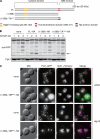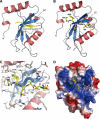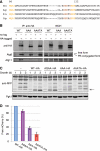Autophagy-related protein 32 acts as autophagic degron and directly initiates mitophagy
- PMID: 22308029
- PMCID: PMC3323008
- DOI: 10.1074/jbc.M111.299917
Autophagy-related protein 32 acts as autophagic degron and directly initiates mitophagy
Abstract
Autophagy-related degradation selective for mitochondria (mitophagy) is an evolutionarily conserved process that is thought to be critical for mitochondrial quality and quantity control. In budding yeast, autophagy-related protein 32 (Atg32) is inserted into the outer membrane of mitochondria with its N- and C-terminal domains exposed to the cytosol and mitochondrial intermembrane space, respectively, and plays an essential role in mitophagy. Atg32 interacts with Atg8, a ubiquitin-like protein localized to the autophagosome, and Atg11, a scaffold protein required for selective autophagy-related pathways, although the significance of these interactions remains elusive. In addition, whether Atg32 is the sole protein necessary and sufficient for initiation of autophagosome formation has not been addressed. Here we show that the Atg32 IMS domain is dispensable for mitophagy. Notably, when anchored to peroxisomes, the Atg32 cytosol domain promoted autophagy-dependent peroxisome degradation, suggesting that Atg32 contains a module compatible for other organelle autophagy. X-ray crystallography reveals that the Atg32 Atg8 family-interacting motif peptide binds Atg8 in a conserved manner. Mutations in this binding interface impair association of Atg32 with the free form of Atg8 and mitophagy. Moreover, Atg32 variants, which do not stably interact with Atg11, are strongly defective in mitochondrial degradation. Finally, we demonstrate that Atg32 forms a complex with Atg8 and Atg11 prior to and independent of isolation membrane generation and subsequent autophagosome formation. Taken together, our data implicate Atg32 as a bipartite platform recruiting Atg8 and Atg11 to the mitochondrial surface and forming an initiator complex crucial for mitophagy.
Figures





Similar articles
-
Mitochondria-anchored receptor Atg32 mediates degradation of mitochondria via selective autophagy.Dev Cell. 2009 Jul;17(1):87-97. doi: 10.1016/j.devcel.2009.06.013. Dev Cell. 2009. PMID: 19619494
-
Atg32 is a mitochondrial protein that confers selectivity during mitophagy.Dev Cell. 2009 Jul;17(1):98-109. doi: 10.1016/j.devcel.2009.06.014. Dev Cell. 2009. PMID: 19619495 Free PMC article.
-
Phosphorylation of Serine 114 on Atg32 mediates mitophagy.Mol Biol Cell. 2011 Sep;22(17):3206-17. doi: 10.1091/mbc.E11-02-0145. Epub 2011 Jul 14. Mol Biol Cell. 2011. PMID: 21757540 Free PMC article.
-
Receptor-mediated mitophagy in yeast and mammalian systems.Cell Res. 2014 Jul;24(7):787-95. doi: 10.1038/cr.2014.75. Epub 2014 Jun 6. Cell Res. 2014. PMID: 24903109 Free PMC article. Review.
-
Regulatory mechanisms of mitophagy in yeast.Biochim Biophys Acta Gen Subj. 2021 May;1865(5):129858. doi: 10.1016/j.bbagen.2021.129858. Epub 2021 Feb 3. Biochim Biophys Acta Gen Subj. 2021. PMID: 33545228 Review.
Cited by
-
The Emerging Roles of Autophagy in Human Diseases.Biomedicines. 2021 Nov 9;9(11):1651. doi: 10.3390/biomedicines9111651. Biomedicines. 2021. PMID: 34829881 Free PMC article. Review.
-
Autophagy in C. elegans development.Dev Biol. 2019 Mar 1;447(1):103-125. doi: 10.1016/j.ydbio.2018.04.009. Epub 2018 Apr 27. Dev Biol. 2019. PMID: 29709599 Free PMC article. Review.
-
Pex3-anchored Atg36 tags peroxisomes for degradation in Saccharomyces cerevisiae.EMBO J. 2012 Jun 29;31(13):2852-68. doi: 10.1038/emboj.2012.151. Epub 2012 May 29. EMBO J. 2012. PMID: 22643220 Free PMC article.
-
Organellophagy: eliminating cellular building blocks via selective autophagy.J Cell Biol. 2014 May 26;205(4):435-45. doi: 10.1083/jcb.201402054. J Cell Biol. 2014. PMID: 24862571 Free PMC article. Review.
-
Backbone and side chain resonance assignments for a structured domain within Atg32.Biomol NMR Assign. 2017 Oct;11(2):211-214. doi: 10.1007/s12104-017-9750-y. Epub 2017 Aug 1. Biomol NMR Assign. 2017. PMID: 28766175 Free PMC article.
References
-
- Weidberg H., Shvets E., Elazar Z. (2011) Biogenesis and cargo selectivity of autophagosomes. Annu. Rev. Biochem. 80, 125–156 - PubMed
-
- Mizushima N., Yoshimori T., Ohsumi Y. (2011) Annu. Rev. Cell Dev. Biol. 27, 107–132 - PubMed
-
- Okamoto K., Kondo-Okamoto N. (2012) Biochim. Biophys. Acta in press - PubMed
Publication types
MeSH terms
Substances
LinkOut - more resources
Full Text Sources
Other Literature Sources
Molecular Biology Databases

